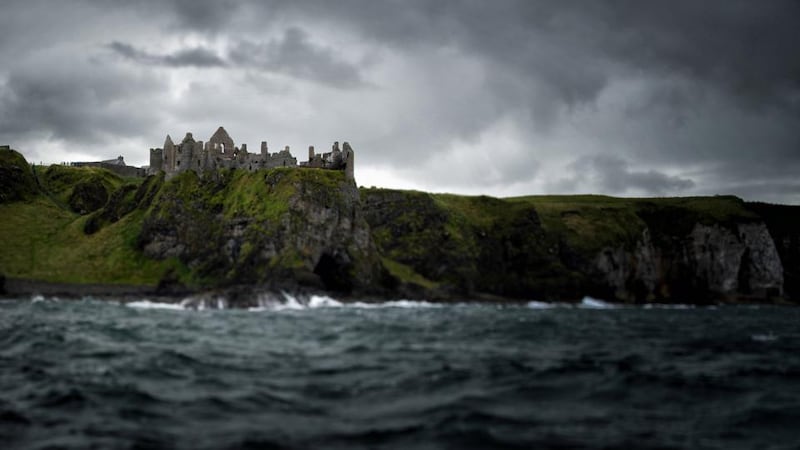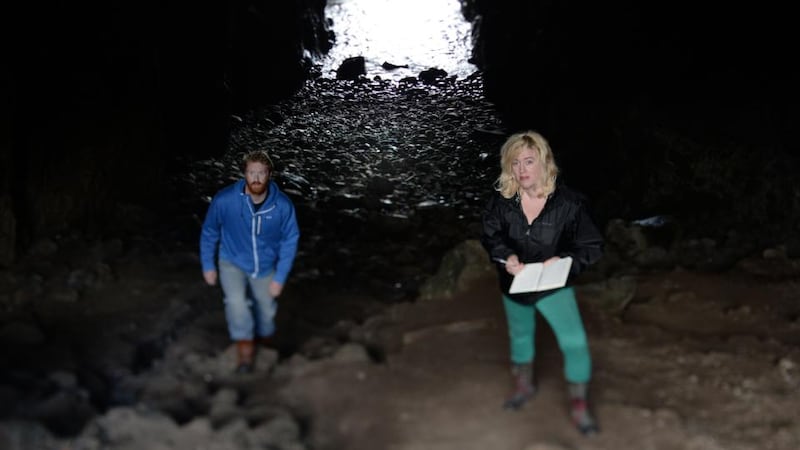If there's one man who knows the ripped and rugged north Antrim coastline inside out, as well as outside in, it's big-wave surfer Al Mennie. He is in his element in these mercurial waters – which are benign one moment, treacherous the next – having been immersed in them almost all his life.
As a nine-year-old he wobbled on his first surf board at the beach at Castlerock. Now, aged 32, he is a dedicated hunter of the most powerful waves to reach these shores, and he retains a deep connection with the place he calls home.
Mennie, tall and strapping, and with a distinctive ginger beard – he is locally known as Big Red – cuts an unmistakable figure around Portrush, the traditional dodgems-and-chips seaside resort where he grew up and still lives. He can’t walk 10m along the pavement without people stopping him to say hello.


And it’s here, at the harbour, on a changeable Sunday afternoon, that he has promised to meet me and whisk me off on a boat tour of the hidden corners of the Causeway Coast.
Any last scraps of blue are rapidly disappearing from the sky as we set off, with Mennie’s mate, skipper Crawford Rankin, at the helm. The waves beyond Ramore Head look mean and choppy. Sure enough, once we’re out of the shelter of the harbour wall, it’s a tumultuous ride, as we whizz up one side of each rearing bruiser, then come bouncing down the other. But Mennie and Rankin are reassuringly sanguine, conceding only that there might be “a bit of a pop” as we round the headland.
Off to the sea caves
We are in search of the mighty sea caves gouged into the cliffs all along this part of the coast. Once they were celebrated destinations for boatloads of Victorian holiday-makers, who would row into the dark caverns to picnic and paint, and shiver at the tales of smugglers and drowned sailors and animal spirits. Sometimes, a guide would be waiting inside with a gun, which he would fire as the boats entered the cavern, causing the cave to resound with the report, and the seabirds within to flock out above the heads of the visitors.
One cave, known as Portcoon, was admiringly compared to “the aisle of a great Gothic cathedral”, while those on Rathlin Island, off Ballycastle, were rumoured to be the stalking grounds of the devil himself. Today the caves, several of which are accessible only by sea, have become largely forgotten by the thousands of tourists who flock to well-known attractions such as the Giant’s Causeway and the Carrick-a-Rede rope bridge.
A bull seal watches us from his solitary rock as we pass the Skerries, a chain of 17 uninhabited islands, populated by black and white rabbits.
According to Mennie, a local man, Mac O’Neill, rowed the rabbits out there himself, hoping that puffins would nest in the burrows they created. Fifteen years later, there’s no sign of puffins, but the rabbits have certainly made themselves at home, scampering about among the young of the black-backed gulls, which ignore them and pick disconsolately at bits of seaweed.
Further on, we see fulmars and cormorants, and blue-eyed gannets diving for fish. Rankin explains that the gannets have a sac in their neck that they expand at the last possible second before they hit the water, in order to stop the delicate vertebrae shattering on impact.
Out there on the sea, with the clouds gathering in the west, and the land receding behind us, it feels wild and bleak and lonely. But that’s just how Mennie likes it.
In March last year, he paddle-boarded for almost 50km across the treacherous North Channel, to the Scottish island of Islay – the shadowy form of which we can just glimpse, far away on the horizon – to raise money for charity.
“Yes, the water can be cold and murky, not inviting at all. But I prefer it that way. I’m attuned to this place. I put my wetsuit back on when it’s still wet and I just get out there. You get these bleak midwinter days here when you’re almost being suffocated by the weather, and the visibility is really low, between the squalls and the mizzly rain. If you surf then, in those kinds of conditions, it’s because you really want to do it.”
The Mermaid Cave
As Rankin swings the boat round, we can see the mouths of smaller caves opening like dark doorways in the limestone and basalt cliffs, and gradually we approach the largest and most impressive one: the Mermaid Cave, yawning deep under the cliff beneath the medieval castle of Dunluce.
Many old stories are told about this place. It's said that when Maeve Roe, the only daughter of Lord McQuillan of Dunluce, refused to take Rory Oge as her husband, her father imprisoned her in the northeastern tower of the castle. On a stormy night, her true love, Reginald O'Cahan, attempted to rescue her; the couple tried to make their escape by boat, through the great cave, but they were dashed against the cliffs of the White Rocks. The body of Maeve Roe was never found, and legend has it that her ghost still sweeps her prison tower in Dunluce.
"These are the stories I heard when I was growing up," says Mennie, who also recounts how Spanish noblemen and sailors who drowned in the wreck of the Girona, part of the Spanish Armada, in 1588, were buried in unmarked graves in the tiny churchyard of St Cuthbert's, close to Dunluce.
The stark beauty of the place, its eerie loneliness, makes it easy to see how such tales take hold of the local imagination.
Later, back on dry land, Mennie and I drive to Dunluce Castle and climb down into the Mermaid Cave. The sheer scale of it is extraordinary; those soaring, cathedral-like proportions so admired by the Victorians. It is dim and cool, and the silence is punctuated only by the odd drip of water, and the ceaseless sound of the sea advancing and retreating at the mouth of the cave. There is something uncanny about it; you feel relieved when you emerge from that brooding darkness, back among the chatter of the tourists visiting the castle.
'There's nowhere else like it'
For Mennie, the sea caves are just one part of a coastline of incredible diversity. "You get so much in such a short space," he says. "From Dunseverick to Magilligan, the full length of the coast, you have these long sweeps of beaches, the cliffs, the countryside, the caves . . . there's just nowhere else like it."
He retains a particularly soft spot for his home town of Portrush. “I spend a lot of time just sitting on the beach at the West Strand. You get a sunset here every evening, you know. You can stay down there until it’s dark, or you can sit behind the harbour wall, and then, when the sun goes down, you look up and the sky is full of stars. I’m telling you, it’s beautiful.”
Antrim coast: Great, sweeping vistas
The most spectacular part of the Causeway Coast runs from Ballycastle to just before Portrush, a distance of about 32km, where much of the road follows the twists and turns of the sea cliffs, and almost every corner opens up a new expanse of dramatic coastline. It's often described as one of the world's great road journeys, albeit a fairly short one, but you will see more on foot.
Castles, churches and tiny fishing villages add curiosity and colour, yet it’s the great, sweeping vistas – particularly the view over White Park Bay, a glorious expanse of pale golden sand – that really stir the soul. In spring, the grassy sand-dunes around the bay are carpeted with primroses in their thousands, which makes it worth a visit all on its own.
It’s a glorious spot for a picnic, but don’t swim there; like many parts of the Causeway shore, there are dangerous currents that can drag the unwary out to sea in an instant. If you want to bathe, try the blue-flag beaches at Whiterocks or Portrush West, or, further round the coast, Portstewart Strand and Benone.
Attractions and activities
The Giant's Causeway, with its controversial new visitors' centre – it brought the wrath of Richard Dawkins when it emerged that it contained a creationist account of the formation of the famous stones – is the main stop on the tourist trail. Close by is the Carrick-a-Rede Rope Bridge, which sways 30m above seawater. On second thoughts, best not look down.
Another curiosity is Mussenden Temple, a nexotic-looking structure perched on a cliff top with views westward over Downhill Strand. Inspired by the Temple of Vesta in Tivoli, near Rome, it was built as a summer library for the Bishop of Derry in 1783. Bushmills Irish Whiskey is made at Ireland’s oldest working distillery in the village of the same name; you can watch the process and, of course, sample a snifter. The heady scent of the place alone makes it worth a visit. For more earthy pleasures, Barry’s Amusements in Portrush has been entertaining families for generations. And this year – the hottest summer for decades – the town boasts its own outdoor ice rink.
If you’re hungry, everyone’s default option is the Ramore wine bar at the harbour at Portrush, which is so popular it has to operate a ticket system. It’s true that their tobacco onions are hard to beat, but the Bushmills Inn, where you dine in the converted 17th-century stable yard, may present a less frenetic option (try the Sunday carvery) and you can sleep there too. Or stay the night at Whitepark House with Bob Isles, sometime winner of UK landlady of the year – comfy beds, wonderful views towards the Scottish islands of Islay and Jura, and cakes so light you’ll float away.









